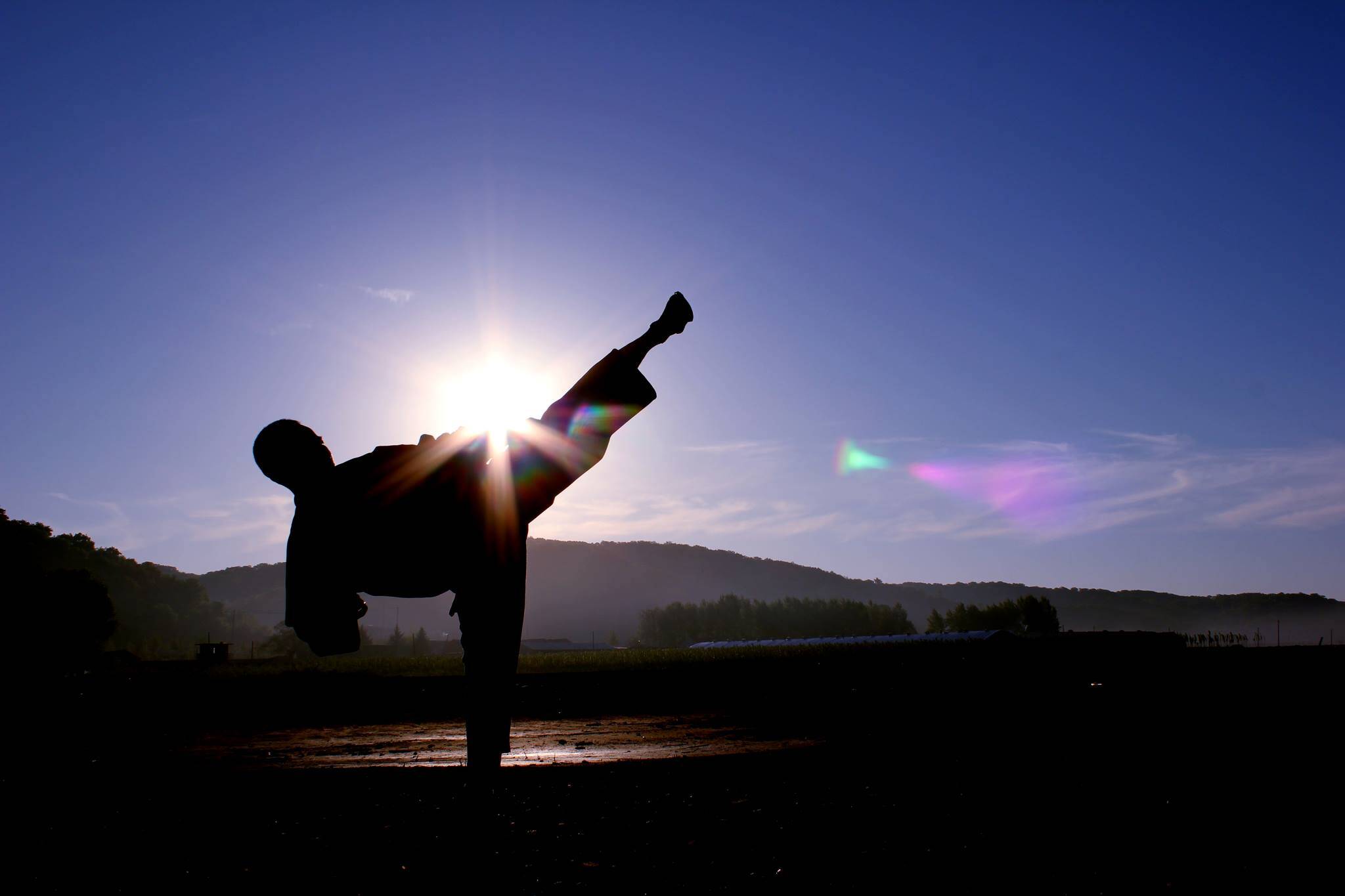Definition of Kick
Simply speaking, any martial gesture involving one or two legs, targeting any of your opponent’s body part, is considered a kick. Okay, we hear you: “I don’t need a degree for understanding such a simple notion!”, and we agree, although this basic understanding is as simple as necessary to point out, because sometimes Martial Artists tend to spend so much time in searching – and training – for the ultimate twisting-tornado kick, that they forget why kicks are essential and how to throw a kick correctly.
It’s in the simplicity of the most basic kick that lies victory in combat
Superiority of Kicking over Punching
Kicks are better than punches for the following reasons:
- a kick is more powerful than a punch. Always. The reason is found in simple physics: you are moving more mass; secondly you don’t need to condition your feet to avoid hurting yourself, making a kick superior regardless.
- punching calls for infections (if you punch the wrong guy), while kicking does not (if we consider a real situation, where you are supposed to wear shoes, unlike most common sport tournaments, where fighters are not allowed to wear any type of footwear – except for Savate -)
- if you are crippled in your arms, you can still kick. If you are crippled in your legs, you just don’t have many options left…
- a kick keeps the opponent away, allowing you to avoid opting for the short-distance combat, while punching undoubtedly exposes you more, under this point of view.
- as explained at point one, kicking is like sparring wearing heavy gloves 100% of the time. This means further protection, more damage, and less pain on impact.
- If you apply the exact intensity of your lower body workout to your arms, you will be always one step ahead of them, as a well trained lower body not only makes your kicks more effective, but increases your chances of moving easier and with more agility during a fight (or stepping away more quickly, if fighting is not what you want).
Types of Kicks in Martial Arts.
just like in music, seven are the musical notes, but infinite the combinations you can get.
Most important, each Martial Style names its types of kicks in its own way, so it will be pointless to name them all in this article. What we want to expose here are the macro-categories that all types of kicks in Martial Arts can be divided into, so you can have a general sense of their strength and weakness.
Regardless of the style you are studying, kicks can be divided into the following macro-groups:
- Front Kicks
- Side Kicks
- Roundhouse kicks
- Spinning Kicks
- Flying or Acrobatic Kicks
- Guard-Opening Kicks
- Sweeps
Front Kicks: when Simplicity meets Deadliness
Extremely efficient, front kicks are those types of martial gestures that don’t require any warm-up to be thrown (unless you are searching for extremely high-kicks) and can be executed at a very high speed due to their simplicity and the total absence of twisting of the supporting foot (a principle that other kicks, instead, have).
First and foremost, let’s explain the difference between a front kick and a front throw, as despite both gestures share the same principles, huge are the differences between them.
- A kick, to be effective, must be hard to block: and this is the first difference. A front kick is supposed to be charged first, and then extended in a direction that is parallel to the ground. To be 100% effective, force must be straight, from A to B (from one opponent to the other). To perform a proper front kick (push-kick), the knee must be first lifted, then the foot pushed towards the opponent. Foot can be flat or pointy, following the rule of the hammer: you can use the head or the peen according to the effect you wish to obtain.
- Front throw. A front throw, on the other hand, can be performed in two ways: by first charging it (like in the front kick explained above) and then thrusting it, or by thrusting the whole straight leg. The main difference compared to the front kick is clearly its execution, which is mainly a curve. So, the question is: which of the two is the most effective? Here’s your answers:
Front Kicks:
- Extremely hard to block
- Extremely powerful when executed parallel to the ground
- Do not require extreme flexibility
- They are limited in height when targeted at their highest range
- Perfect for short and long distance combat
Front Throws:
- Easier to predict, and therefore to intercept
- Not as deadly as a front kicks, due to the nature of impact
- Require a very good flexibility
- Have no limits in height if performed by athletes with very good flexibility
- They are more practical in long-distance combat
Side Kicks
Side Kicks are very similar in power to front kicks, but they require more flexibility; side kicks can be compared to a four-stroke engine, while front kicks to a two-stroke engine: both can be devastating, but side kicks release power in virtually double the time, as they are not that “immediate” when compared to their brothers font kicks.
Side kicks are slightly more powerful than front kicks because they are immune to the “bounce back” feedback, which in short is the loss of power caused by insufficient foot grounding, which only a side kick can provide.
The golden Principle of Pedestal
Font kicks are still powerful, but a Martial Expert has to be conscious of the fact that his or her mass has to be thrown towards the opponent to compensate his or her stability: a side kick, instead, has the advantage of relying on the foot: in fact, when the supporting foot is rotated by 180°, stability is guaranteed even at extreme heights.
Round-house kicks
Round-house kicks (often referred to as circular kick) are extremely powerful kicks, but only on condition that legs are properly conditioned. These types of kicks no more rely on what lies underneath your feet, but exclusively on your Bone and Muscle Conditioning (see BMC), because the top of your foot and tibias are now the most involved part.
Round-house kicks can be low, medium or high, and the rotation of the foot is directly proportional to the height a Martial Practitioner wants to achieve.
Spinning Kicks
Spinning Kicks take advantage of the rotation of the body to generate more power. They are clearly superior in terms of power, but they need to be executed fast if you want to avoid being intercepted: after all, you are still giving your back to your opponent, so make sure you are fast in spinning, otherwise you will risk a lot…
Flying or Acrobatic Kicks
They are the most beautiful-to-look-at kicks, although they require extreme flexibility and an insane level of mastery to be effective, not to mention that they can be used only in limited situations, which involve factors such as distance and surrounding conditions.
Guard-Opening Kicks
Taking advantage of the main feature Kicks are famous of (power over punches), some Athletes just prefer to use these types of kicks for destroying the opponent’s guard, and then having a chance to continue the fight in a way that is most congenial to him or her.
Sweeps
Basing their concept on “cutting the problem to the root”, sweeps are a deadly method to catch the opponent off-guard. There are only three conditions:
- your mass must be equal or more than your opponent
- your legs – especially your calves – must be properly conditioned
- you have to be aware of what you are risking if your attack fails







